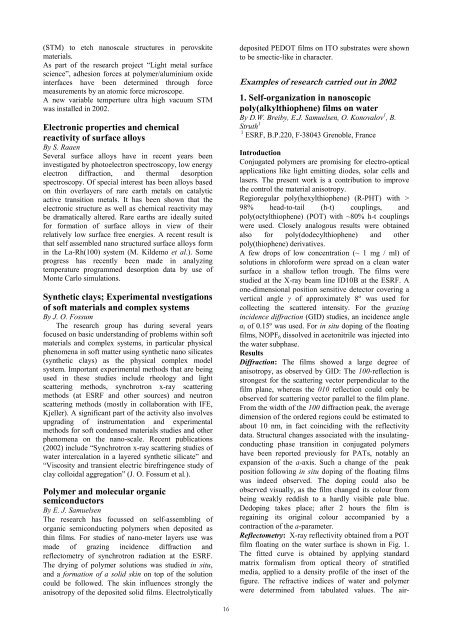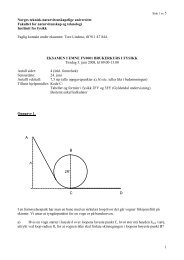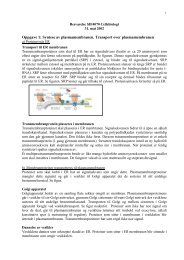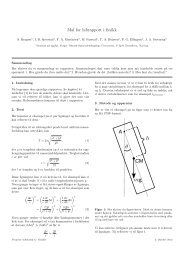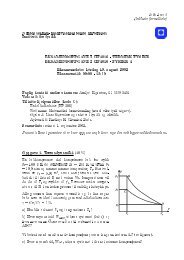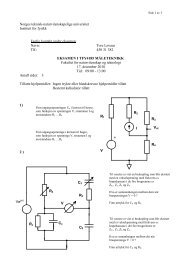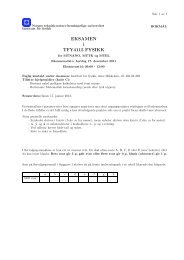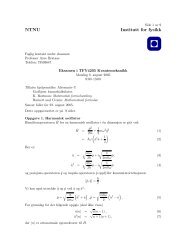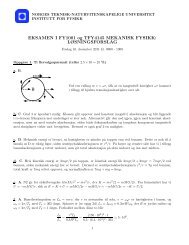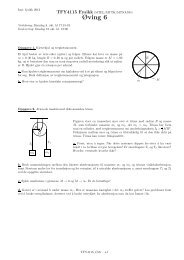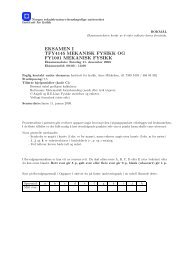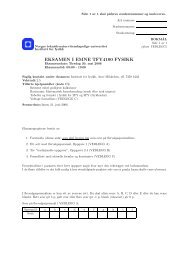DEPARTMENT OF PHYSICS, NTNU - intern - NTNU
DEPARTMENT OF PHYSICS, NTNU - intern - NTNU
DEPARTMENT OF PHYSICS, NTNU - intern - NTNU
Create successful ePaper yourself
Turn your PDF publications into a flip-book with our unique Google optimized e-Paper software.
(STM) to etch nanoscale structures in perovskite<br />
materials.<br />
As part of the research project “Light metal surface<br />
science”, adhesion forces at polymer/aluminium oxide<br />
interfaces have been determined through force<br />
measurements by an atomic force microscope.<br />
A new variable temperture ultra high vacuum STM<br />
was installed in 2002.<br />
Electronic properties and chemical<br />
reactivity of surface alloys<br />
By S. Raaen<br />
Several surface alloys have in recent years been<br />
investigated by photoelectron spectroscopy, low energy<br />
electron diffraction, and thermal desorption<br />
spectroscopy. Of special interest has been alloys based<br />
on thin overlayers of rare earth metals on catalytic<br />
active transition metals. It has been shown that the<br />
electronic structure as well as chemical reactivity may<br />
be dramatically altered. Rare earths are ideally suited<br />
for formation of surface alloys in view of their<br />
relatively low surface free energies. A recent result is<br />
that self assembled nano structured surface alloys form<br />
in the La-Rh(100) system (M. Kildemo et al.). Some<br />
progress has recently been made in analyzing<br />
temperature programmed desorption data by use of<br />
Monte Carlo simulations.<br />
Synthetic clays; Experimental nvestigations<br />
of soft materials and complex systems<br />
By J. O. Fossum<br />
The research group has during several years<br />
focused on basic understanding of problems within soft<br />
materials and complex systems, in particular physical<br />
phenomena in soft matter using synthetic nano silicates<br />
(synthetic clays) as the physical complex model<br />
system. Important experimental methods that are being<br />
used in these studies include rheology and light<br />
scattering methods, synchrotron x-ray scattering<br />
methods (at ESRF and other sources) and neutron<br />
scattering methods (mostly in collaboration with IFE,<br />
Kjeller). A significant part of the activity also involves<br />
upgrading of instrumentation and experimental<br />
methods for soft condensed materials studies and other<br />
phenomena on the nano-scale. Recent publications<br />
(2002) include “Synchrotron x-ray scattering studies of<br />
water intercalation in a layered synthetic silicate” and<br />
“Viscosity and transient electric birefringence study of<br />
clay colloidal aggregation” (J. O. Fossum et al.).<br />
Polymer and molecular organic<br />
semiconductors<br />
By E. J. Samuelsen<br />
The research has focussed on self-assembling of<br />
organic semiconducting polymers when deposited as<br />
thin films. For studies of nano-meter layers use was<br />
made of grazing incidence diffraction and<br />
reflectometry of synchrotron radiation at the ESRF.<br />
The drying of polymer solutions was studied in situ,<br />
and a formation of a solid skin on top of the solution<br />
could be followed. The skin influences strongly the<br />
anisotropy of the deposited solid films. Electrolytically<br />
16<br />
deposited PEDOT films on ITO substrates were shown<br />
to be smectic-like in character.<br />
Examples of research carried out in 2002<br />
1. Self-organization in nanoscopic<br />
poly(alkylthiophene) films on water<br />
By D.W. Breiby, E.J. Samuelsen, O. Konovalov 1 , B.<br />
Struth 1<br />
1 ESRF, B.P.220, F-38043 Grenoble, France<br />
Introduction<br />
Conjugated polymers are promising for electro-optical<br />
applications like light emitting diodes, solar cells and<br />
lasers. The present work is a contribution to improve<br />
the control the material anisotropy.<br />
Regioregular poly(hexylthiophene) (R-PHT) with ><br />
98% head-to-tail (h-t) couplings, and<br />
poly(octylthiophene) (POT) with ~80% h-t couplings<br />
were used. Closely analogous results were obtained<br />
also for poly(dodecylthiophene) and other<br />
poly(thiophene) derivatives.<br />
A few drops of low concentration (~ 1 mg / ml) of<br />
solutions in chloroform were spread on a clean water<br />
surface in a shallow teflon trough. The films were<br />
studied at the X-ray beam line ID10B at the ESRF. A<br />
one-dimensional position sensitive detector covering a<br />
vertical angle γ of approximately 8º was used for<br />
collecting the scattered intensity. For the grazing<br />
incidence diffraction (GID) studies, an incidence angle<br />
αi of 0.15º was used. For in situ doping of the floating<br />
films, NOPF6 dissolved in acetonitrile was injected into<br />
the water subphase.<br />
Results<br />
Diffraction: The films showed a large degree of<br />
anisotropy, as observed by GID: The 100-reflection is<br />
strongest for the scattering vector perpendicular to the<br />
film plane, whereas the 010 reflection could only be<br />
observed for scattering vector parallel to the film plane.<br />
From the width of the 100 diffraction peak, the average<br />
dimension of the ordered regions could be estimated to<br />
about 10 nm, in fact coinciding with the reflectivity<br />
data. Structural changes associated with the insulatingconducting<br />
phase transition in conjugated polymers<br />
have been reported previously for PATs, notably an<br />
expansion of the a-axis. Such a change of the peak<br />
position following in situ doping of the floating films<br />
was indeed observed. The doping could also be<br />
observed visually, as the film changed its colour from<br />
being weakly reddish to a hardly visible pale blue.<br />
Dedoping takes place; after 2 hours the film is<br />
regaining its original colour accompanied by a<br />
contraction of the a-parameter.<br />
Reflectometry: X-ray reflectivity obtained from a POT<br />
film floating on the water surface is shown in Fig. 1.<br />
The fitted curve is obtained by applying standard<br />
matrix formalism from optical theory of stratified<br />
media, applied to a density profile of the inset of the<br />
figure. The refractive indices of water and polymer<br />
were determined from tabulated values. The air-


